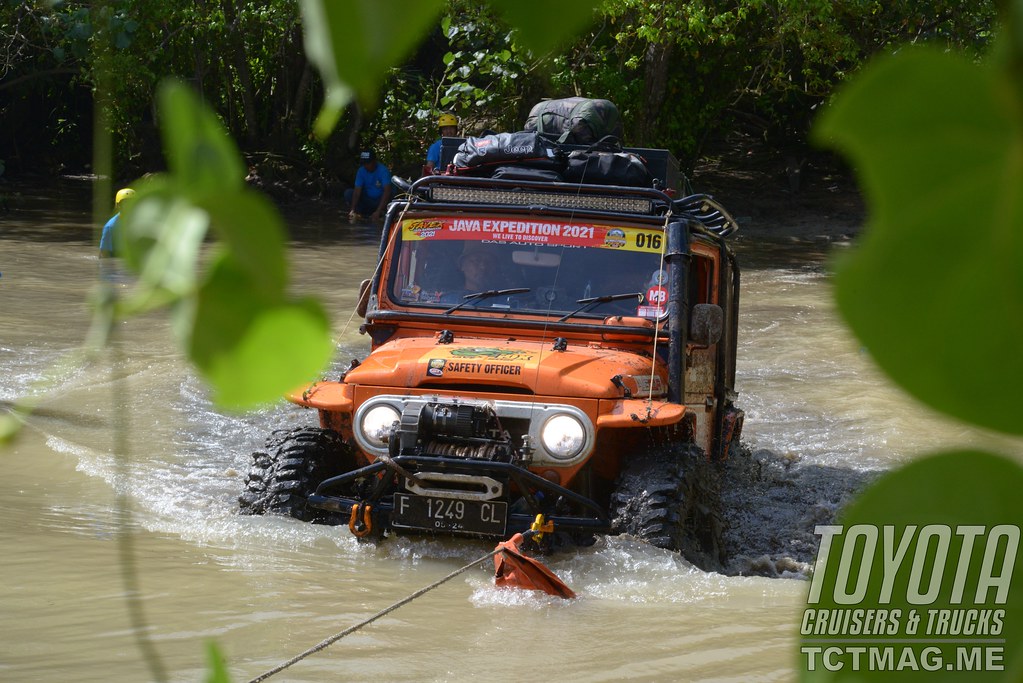While the city sprawls in all directions from the Sultan's palace, the modern city's core is to the north, centered around traditional Dutch colonial buildings. This is the starting point where this adventure begins, at the Pulang Ke Uttara hotel.

Due to local COVID restrictions imposed by the government, the organizers are forced to divide the 75 cars into two separate groups, Merapi and Merbabu, both named after prominent regional active volcanoes.
Both groups have their own team leaders, Pak Syamsir Alam and Pak Agus Halim, who are both very experienced off-roaders and they designed the tracks, conducted the survey, and prepared the entire event organization, which is chaired by Pak Wawan Dalbo.

The Indonesian Off-Road Federation (IOF), or more specifically the IOX Adventure Club, an exhibition and adventure arm of the IOF, is the organizer of this 'JAVEX 2021 Off-Road Expedition', hence there are local standards in places and many years of experience available.
Team KUDANIL, short for Kuda (horse) and Nil, like the river in Egypt or team hippo in English, was my group B assigned team. Five completely different vehicles, but all fully built up and compliant with the event requirements.
This year's KUDANIL teams included Pak Ruben in a Toyota Land Cruiser 70, Pak Andre in a Range Rover P38, Pak Catur in an older Jeep CJ7, Pak Wisnu and Pak Suby in an old Toyota Land Cruiser FJ43, and Pak Sani in a slightly smaller but no less powerful Suzuki Jimny.

It is the rainy season, and the 75 cars are scrutinized in two different outdoor locations, depending on their assigned group, on November 19 and on November 20 2021. All necessary packed and securely stored equipment must be unpacked and re-presented for completeness, compliance and functionality. Winches and other technical equipment are tested and only after a successful scrutinizing the event stickers are issued and the car is declared fit for the event.
On the evening of November 20, 2021, all team leaders received the final briefing, and a warm welcome reception officially kicked off the event on the roof top bar of the Pulang ke Uttara hotel. Participants from all of Indonesia's major islands hadn't seen each other since the last IOX event in 2020, so region-specific snacks were served, and new bonding friendships were formed. What else can you expect from a Pulang Ke Uttara hotel rooftop sunset over Yogyakarta with the Merapi volcano in the distance?
The following morning, there was a symbolic flag off at the Pulang Ke Uttara hotel, symbolic in the sense that groups started individually from their own event headquarters rather than lining up all together in Yogyakarta. At the end of the day, the IOX Off-Road Challenge is not a race with winners; everyone is a winner and everyone is acknowledged as such.

Warming up is essential in any sport, especially 4x4 off-roading, not only for the cars, but also for the individual teams and groups. Everyone must be assigned to a task, and everyone must understand who is doing what, when, and where within their own team and within the group. Finally, because it is a team sport, teams must support one another, whether through winching exercises, technical equipment support, or simply by cooking rice.
So the first few stages were considered easy because they were only a few kilometres outside of Yogyakarta, a simple river crossing and some muddy tracks through old deserted rice paddies, a real warm-up, but ultimately fun after almost two years of not being on the tracks with the cars.
However, as part of the East Java regency, only Blitar should be the true starting point of the IOX Off-Road Expedition. Different regencies issue different permits, and it was only here that we received full support and access to remote forests and beaches, and it was only here that the forgotten beauty of Java's southern coastline shone brightly.

The southern coast of East Java is, in fact, underdeveloped due to historical reasons, with limited road connectivity. As a result, driving from beach to beach is impossible; one must take shortcuts, which is exactly what we did, or were asked to do, beach hopping and taking shortcuts through secondary teak forests, cross country, no roads, no tracks. It would take hours to travel from beach to beach using official roads; one must first drive inland before returning a few kilometres down the road to the beach.
It's easier said than done, especially since it's rainy season and the southern coastline is steep, rocky, and teeming with sharp lime stones. However, there are beaches that are so remote, deserted, and devoid of infrastructure that one might not believe they are on one of Indonesia's over 7,000 islands, far and remote, but this is Java, Indonesia's most populated island.
Fishing and going out to sea are not a real source of income for the people who live in this part of Indonesia, because the southern shorelines are simply too rough and full of spirits, but lobster fishing is, and what better reward is there than boiled lobster and coffee for breakfast or grilled lobster and a cold drink for dinner? And that's exactly what we did, our reward for battling the mud, rain, and uncertainty of muddy tracks and deep ruts day and night.

Related Articles
At the end of the expedition, the Kudanil team's two Land Cruisers had the fewest technical failures throughout the expedition and within the team. Two plasma ropes simply snapped, one panhard rod at the LC80 and two at the FJ43 broke, and one joystick for the winch had to be replaced. In fact, considering the track's toughness, there was very little damage.
Pak Sany, on the other hand, was unlucky, as were Pak Andre and his Range Rover, and Pak Catur with his JEEP CJ7. Four plasma ropes snapped in total, all of which were branded, and one brand new tire was even slit open by sharp rocks. One WARN 8274 winch had to be completely replaced, as well as an alternator, a solenoid switch, a coupling cylinder, and numerous other parts such as an accelerator cable and head lamps.

Yet unconsidered are the numerous dents and scratches. In fact, the orange foil used by all participating cars was intended to provide some protection for the car, but few people remove it and instead keep it on for the next event. In any case, it isn't a protection against true dents caused by trees and rocks.
Following that, one might wonder what the total financial damage in broken parts and missing equipment is with 75 cars participated in total. Millions of Rupiah or thousands of Dollars, plus all the labour required to replace them.

When you cross the finish line near Lumajang in East Java, and group A and B eventually merge again, you feel relieved, happy, and proud. Especially since everyone arrived safely and without any major injuries aside from a few minor scratches here and there.
PS: If you look at the map, you'll notice, that Lumajang is east of the majestic Semeru volcano; in fact, the day before, we passed through the old lava fields and rivers. Exactly one day after the Semeru erupted, and as of this writing, 39 people had died as a result of the volcanic eruption, and members of the expedition are still on site and are providing assistance with their 4x4 vehicles.

Well, IOX members are always present all over Indonesia to assist with relief efforts whenever necessary, and if not, they are all looking forward to the next event in Kalimantan, MEX, where the tribe will gather again for 14 days of rainforest action.
FJ Summit Alumni? Get your retro sticker in our store =)
To get your copy of the
Winter 2022 Issue:
Follow us on Facebook, Twitter, and Instagram to get up-to-date industry news, events, and of course, amazing adventures, stories, and photos!














